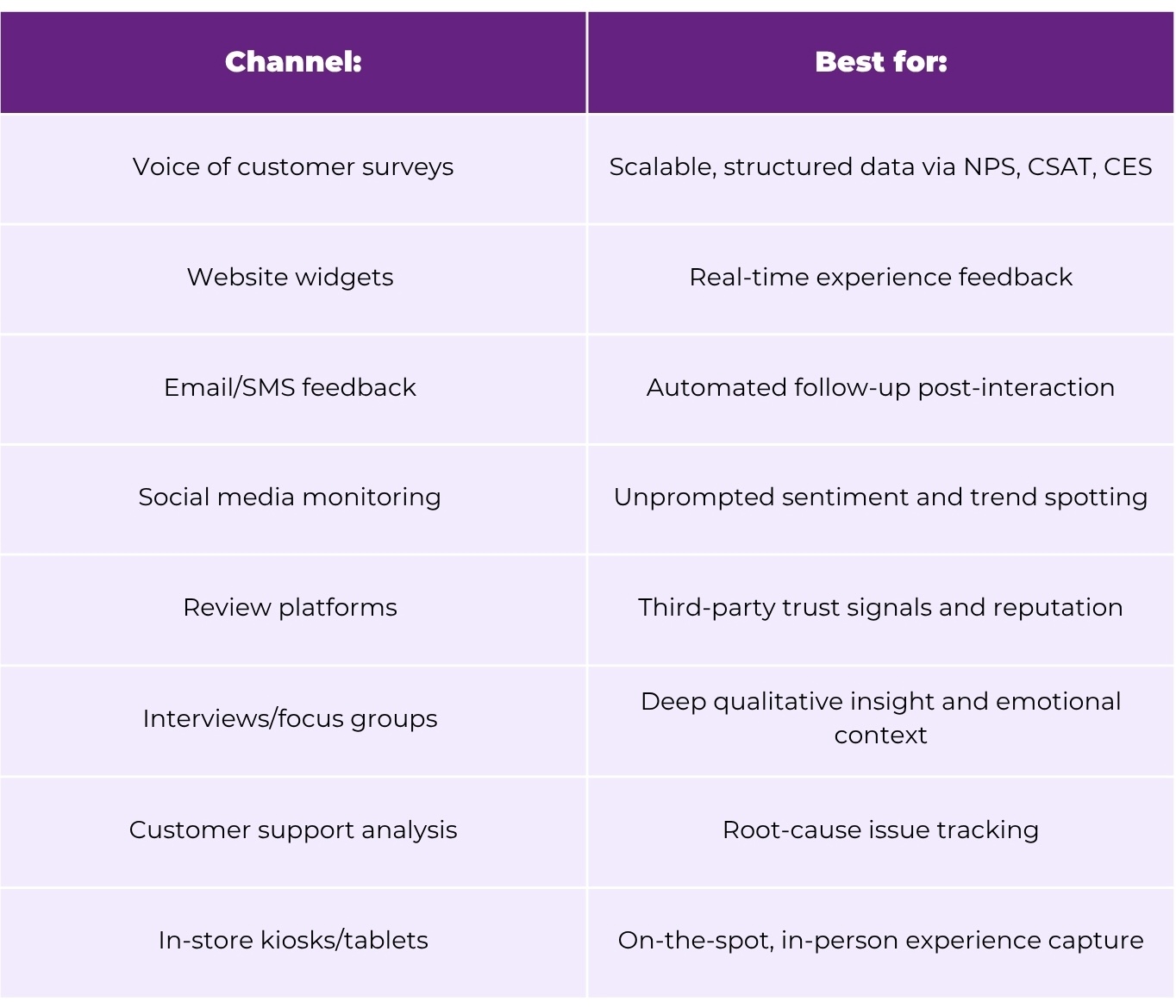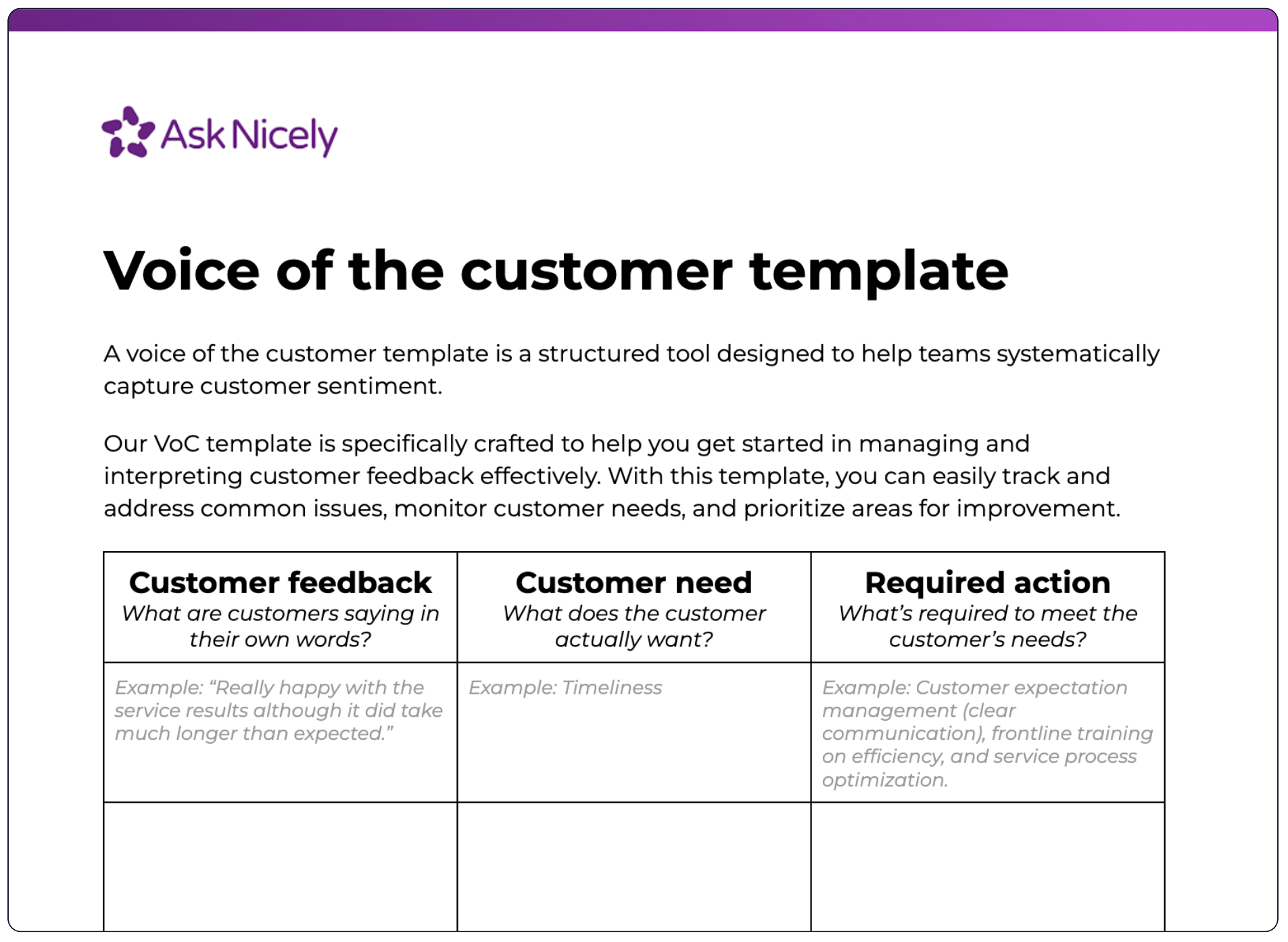%20Template%20_%20Download%20Now%20AskNicely.jpg)
Delivering exceptional customer experiences starts with truly understanding those customers, and that can’t be done without listening.
A strong voice of the customer (VoC) template provides a structured way to capture, analyze, and act on feedback. You can use it to reduce customer churn, improve brand loyalty, and make smarter decisions at every point in the customer journey.
To help you build a system that actually works, we’ve created a free, downloadable VoC template. It’s designed to streamline your feedback process and help you turn insights into action. And the impact is real: according to Forrester, customers are 2.4x more likely to stick with brands that listen and solve problems quickly.
Ignore the voice of your customer, and you risk rising churn rates, ballooning acquisition costs, and blind spots that stall growth.
In this guide, we’ll walk through the key components of a high-performing VoC program, from selecting the right feedback channels to analyzing results and closing the loop. You’ll also learn how to gather and analyze feedback with tools like AskNicely’s survey builder, so your team can move faster and smarter.
Voice of the customer (VoC) is a structured approach to capturing, analyzing, and acting on customer feedback to improve the overall customer experience. By listening to what customers are saying (both directly and indirectly), service brands can uncover insights that drive smarter decision-making, stronger customer relationships, and better business outcomes.
An effective VoC program helps you:
Analyzing VoC data helps identify recurring issues, track shifts in sentiment over time, and enable continuous, data-driven product developments, service improvements, and frontline interactions.
With a downloadable template to guide your process, your team can turn scattered feedback into a clear, repeatable system that keeps the customer’s voice at the center of every decision.
Collecting voice of the customer data requires tapping into multiple feedback channels to get a complete picture of customer sentiment. A well-rounded approach ensures you capture both structured and unstructured feedback across digital and in-person touchpoints.
Here are the most effective ways to collect VoC data:

A strong VoC program doesn’t rely on a single channel; it combines methods to ensure you’re hearing the full customer story. With the right mix and the help of tools like AskNicely’s survey platform, you can turn raw feedback into CX insights that power data-driven decisions.
A voice of the customer template is a structured tool designed to help teams systematically capture customer sentiment.
Our VoC template is specifically crafted to help you get started in managing and interpreting customer feedback effectively. With this template, you can easily track and address common issues, monitor customer sentiment, and prioritize areas for improvement.

Building a customer-centric culture starts with clarity, and that’s exactly what a VoC template delivers. Whether you call it a customer feedback tracker or a VoC worksheet, this structured tool helps teams turn scattered feedback into focused action.
According to Bain & Company, organizations that rapidly respond to customer feedback can grow revenue up to 2.5 times faster than their competitors. Why? Because structure turns insight into outcomes.
Here’s what the right template empowers you to do:
Follow this VoC process to turn customer feedback into meaningful, measurable improvements. Each step is designed to help your team capture the right insights and turn them into action using your voice of the customer template.
Clarify what you want your VoC efforts to achieve, whether it’s improving customer satisfaction, boosting net promoter score (NPS), or refining a specific part of the customer journey. Clear goals give your data collection and analysis purpose.
Bring in the right people early. CX leads, frontline teams, and product managers so feedback reaches the teams who can act on it. Aligning stakeholders ensures insights translate into changes that matter.
Use your VoC template to collect a mix of qualitative and quantitative data through online surveys, interviews, and support logs. Ask the right questions at key moments to capture honest, actionable feedback.
Look for themes, trends, and outliers across feedback types. Your template helps you organize the information so you can spot patterns in customer sentiment and uncover root causes of friction or delight.
Based on your analysis, brainstorm and map out actions to address what customers care about most. Track potential solutions inside your template to link feedback directly to business improvements.
Not all fixes carry equal weight. Use your VoC tracker to rank opportunities based on urgency, customer impact, and ease of implementation—so you can focus on changes that drive the most value.

To get the most value from your VoC template, it’s critical to follow proven VoC best practices. These five tips will help you capture more useful insights, foster cross-team alignment, and take smarter action on customer feedback.
If you’re struggling with low response rates or feedback that feels overwhelming and hard to act on, AskNicely is here to help, fast. Our easy-to-use customer experience platform simplifies how you collect, analyze, and respond to Voice of Customer data, turning valuable insights into meaningful improvements that drive customer retention, loyalty and growth.
Get more responses: Reach customers where they prefer, via targeted email, web, and SMS surveys sent at the right moments to boost engagement and gather richer feedback.
Turn feedback into action: Use AI-powered theme analysis to quickly uncover trends and prioritize the issues that matter most, so your team can focus on what moves the needle.
Close the loop efficiently: Automated workflows and escalation tools route customer concerns to the right people immediately, enabling fast, effective responses that build trust.
Keep improving daily: Frontline teams get real-time visibility into NPS and CSAT scores, along with deeper insights to help them enhance service quality and customer satisfaction continuously.
After implementing AskNicely, Schweiger Dermatology Group saw a more than 3x increase in positive reviews on Google.
See more customer case studies here.
Ready to see how AskNicely can transform your VoC program? Explore a live VoC dashboard or start your free trial today.